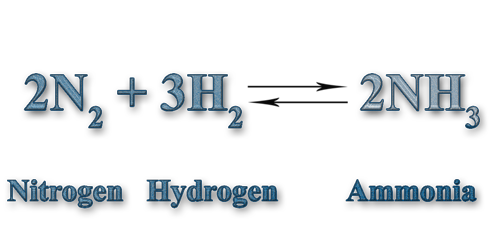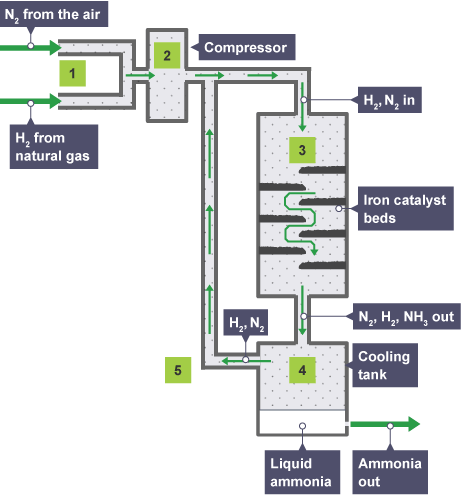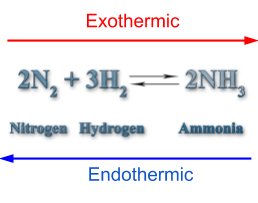The Haber Process
The Haber Process
What you need to know:
Know why the haber process is very useful in industry.
Know the equation for the haber process.
Know the process of the production of ammonia via the haber process.
Know where the reactants come from.
Ammonia __is produced via the __haber process. This involves reacting nitrogen with hydrogen in a special chamber.
The nitrogen comes from the air and the hydrogen comes from reacting methane with steam.
This reaction is reversible, which means that some of the ammonia also breaks down to reform hydrogen and nitrogen.
The haber process chamber looks something like this:
- Nitrogen and hydrogen gas enter the camber.
- The two gases are compressed to increase the pressure
- The compressed gases move into the main body of the chamber where it passes over iron catalysts. The iron catalysts speed up both reactions so that an equilibrium is reached faster.
- The remaining gases leave the chamber along with the newly formed ammonia and enter a cooling chamber. The ammonia is drained out of the bottom of the cooling tank.
- The hydrogen and nitrogen start the cycle again by heading back to the main body of the chamber for reaction.
Haber Process Compromises
What you need to know:
Know why certain environmental conditions are chosen for efficient ammonia production.
This is a very interesting process since there need to be a lot of compromises in order to get the best yield of ammonia.
Temperature
Since the forward reaction is exothermic, decreasing the temperature would favour the forward reaction. However, decreasing the temperature also decreases the rate of reaction! Which means that less product be formed over a certain amount of time! For this reason, a compromise had to be reached of 450℃.
Pressure
Higher pressures favour the forward reaction (since there are less molecules on the right hand side) and also increase the rate of reaction. However, it is very expensive to create high pressures, to a compromise is reached of 200 atmospheres. This makes a good yield for a relatively low price.
Iron Catalyst
The iron catalyst makes the reaction go faster. It doesn’t favour one side over another. With a catalyst, it decreases the amount of temperature is needed for a good reaction.
NPKFertilisation
What you need to know:
Understand why NPK fertilizers are very useful.
Know the equation for production of NPK fertilizers.
Plants need certain nutrient in order to survive and have a healthy growth. Sometime the soil is lacking these nutrients due to a previous crop. Fertilizers can be used to provide the soil with these nutrients.
NPK fertilizers are fertilizers that contain nitrogen, phosphorus and potassium (hence, NPK). It contains these in the right quantities for the plant.
Nitrogen compounds in fertilizers
Ammonia can be used to create ammonium nitrate. Ammonium nitrate is especially good since it has a high percentage of nitrogen.
Producing fertilizers
Fertilizers that are developed in the laboratory do not need to be made on large or continuous scale. Whereas, fertilizers made in industry usually need to be made on a large and continuous scale. For this reason, there are different ways of producing fertilizers, and these depend on the circumstances.



